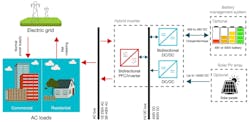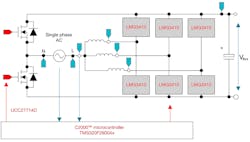What you’ll learn:
- Implementing bidirectional power conversion in a solar installation.
- How WBG materials play a key role in high-voltage power conversion.
- Developing higher-accuracy voltage and current sensing/monitoring.
While photovoltaic (PV) solar installations continue to ramp up, the imbalance between the supply and demand sides of the solar grid has emerged as a major limitation. Solar energy is abundantly available around noon, when demand isn’t high, which means that consumers pay a higher cost per watt during peak usage in the morning and evening.
Energy-storage systems (ESSs) for residential, commercial, and utility solar installations enable inverters to store energy harvested during the day or pull power from the grid when demand is lowest, delivering this stored energy when demand is high. By adding an ESS to a solar grid-tie system, users can reduce costs through a practice known as “peak shaving.”
In this article, I’ll explore design considerations in a grid-connected, storage-integrated solar installation system.
Bidirectional Power Conversion
Conventional solar installations comprise unidirectional dc-ac and dc-dc power stages, but a unidirectional approach presents a major barrier to ESS integration. It requires more components, modules, and subsystems, all of which significantly raise the cost of incorporating an ESS to an existing solar installation.
Adding storage to an existing solar installation entails combining two paths to charge and discharge the battery into a single path comprising both power factor correction (PFC) and inverter power stages. But how do you build bidirectional power converters to replace two unidirectional power converters?
The advanced bidirectional power topologies shown in Figure 1 enable the safe, efficient transfer of power between the grid, PV array, and battery-management system. Microcontrollers (MCUs) such as C2000 real-time MCUs are popular for such power topologies. These controllers can each control one or multiple power stages to enable a digitally controlled, bidirectional power-conversion architecture for an ESS-enabled solar inverter. MCU-enabled control facilitates more sophisticated pulse-width-modulation (PWM) schemes for the power switches handling the dc-ac and dc-dc conversions.
A hybrid inverter helps conversion stages achieve greater efficiency, which becomes far more important in an ESS-integrated microgrid because multiple power conversions are happening. Power-converter systems handle dc-dc operations to charge and discharge batteries, as well as dc-ac and ac-dc operations that convert the dc power stored in the battery into ac to feed it into the grid and back.
Higher-Voltage Batteries
In a storage-integrated microgrid system, a battery’s primary function is to store PV energy and inject power into the grid when prompted. Lithium-ion battery packs offer much higher charge-storage capability per unit than lead-acid batteries.
With 400-V battery packs becoming popular in the electric-vehicle (EV) segment, there’s also a push toward increasing battery voltages in solar power-grid installations beyond 48-V battery packs. But how do you manage power conversions for 400-V battery packs?
Along with MCUs that provide system control and communication to help ESSs integrate into larger systems, power switches with low losses and high efficiency also make energy-storage systems safe and reliable. Compact power switches based on silicon-carbide (SiC) and gallium-nitride (GaN) materials, along with real-time control MCUs, help ensure the adaptation of a bidirectional converter so that it can operate with various dc energy-storage units (Fig. 2).
Wide-bandgap (WBG) semiconductors such as SiC and GaN will play an important role in addressing power-conversion systems that can handle increased battery-voltage ranges given the converter’s higher power density and lower switching losses. Power-conversion systems also help battery packs better manage power fluctuations in distributed generation systems, and make grid operations smart and resilient at higher and wider voltage ranges.
Eventually, solar installations might mimic the battery packs used in EVs. There’s a growing belief that the battery packs currently used in EVs will be recycled for a second life as a grid-connected ESS.
WBG Materials for Efficiency and Natural Convection
To create a sleek wall-mounted storage system, you must ensure that the inverter design is thermally optimized with minimal natural convection cooling. A distributed power architecture can spread the concentration of heat throughout the system. Such architectures also enable the energy-storage inverter needed to support high current levels at different voltages, and to provide a reliable transient response to rapidly changing loads.
Such a system will require gate drivers that can support fast switching and provide protection at switching frequencies from 100 to 400 kHz. If switching isn’t fast enough, power-conversion stages can suffer huge efficiency losses.
That’s where WBG materials such as SiC and GaN come into play, offering faster switching and higher power density. These semiconductor devices facilitate design systems that don’t require fan-based cooling. The LMG3425R030, a GaN device with integrated driver and protection features, provides a compact form factor, higher power density, and faster switching capabilities.
The gate driver translates the digital PWM signal from the controller to the current required by the SiC or GaN field-effect transistor. The PWM-based controllers ensure that voltages and currents are accurately sampled at multiple power-conversation stages.
The Bidirectional High-Density GaN CCM Totem Pole PFC Using C2000 MCU reference design includes a bidirectional totem-pole bridgeless PFC power stage that employs a C2000 real-time MCU and the LMG3410R070 GaN FET with integrated driver and protection (Fig. 3). The 3-kW bidirectional design supports phase shedding and adaptive dead time for efficiency improvements, and a nonlinear voltage loop to reduce voltage spikes during transients in PFC mode.
Current and Voltage Sensing
Power design switching at high frequencies includes the challenge of accurate current and voltage sensing. Shunt-based current measurements aren’t only more accurate, but they also offer faster response times to react quickly to any change in the grid, shutting off the system in case of a short circuit or grid connection loss.
Current measurements are an inherent part of inverter-centric designs because control algorithms require current sensing for control purposes. Design solutions are available for isolated current measurements using external shunts and isolated amplifiers or modulators and power supplies. For example, the Three-Level, Three-Phase SiC AC-to-DC Converter Reference Design employs the AMC1306 isolated modulator for load current monitoring. The AMC3306 is a next-generation isolated modulator with integrated dc-dc converter that enables single-supply operation.
For any digital signals that need to transfer data across various voltage domains in inverter-driven applications using higher voltages, isolation devices could be used to overcome voltage limitations. Digital isolators such as the ISO7741 enable high-frequency signals to cross power boundaries, while protecting low-voltage digital circuits from the high-voltage domain.
Power converters have to measure the grid current to ensure that the current is in phase with the voltage. Current and voltage measurements also control the battery-charging current as well as inverter operation and overload protection.
Conclusion
Hybrid inverters, which provide bidirectional ac-dc and dc-dc power conversions, will likely replace traditional solar inverters in a few years. Hybrid inverters are allowing solar inverter designers to implement power conversions with a wide range of output power and voltages.
For storage-capable solar inverters, higher and wider battery-voltage ranges matter. Along with the need for high efficiency and natural convection, basic building blocks such as MCU-based control and WBG semiconductors with integrated gate-driver and protection features can accommodate these higher and wider battery-voltage ranges.
C2000 real-time MCUs and LMG3425R030 GaN devices are able to handle bidirectional energy transport in a storage-capable solar grid. Likewise, shunt-based current and voltage sensing can ensure that higher voltage batteries and fast switching power converters work safely and reliably.



